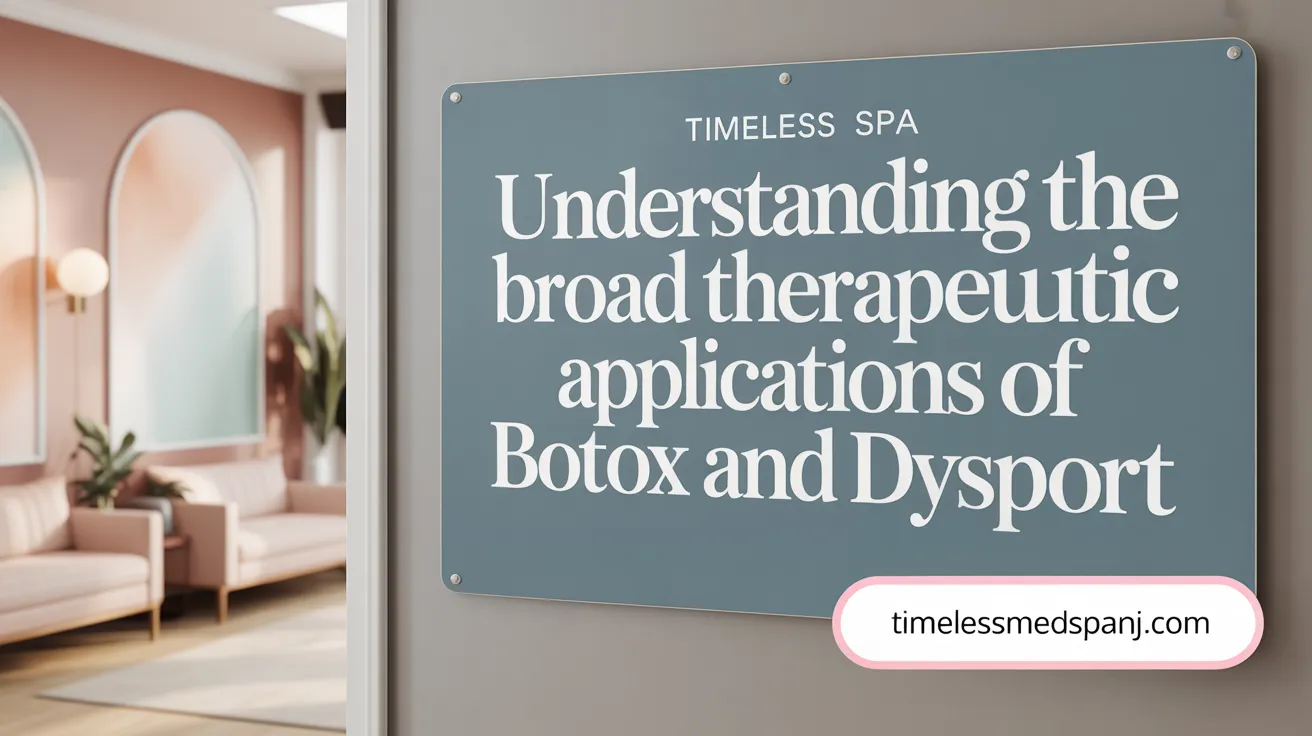Introduction to Therapeutic Uses Beyond Aesthetics
Botox and Dysport, widely recognized for their cosmetic capabilities in smoothing wrinkles and fine lines, possess extensive therapeutic benefits that significantly impact various medical fields. Both derive from botulinum toxin type A, which temporarily relaxes muscles by blocking nerve signals. This article explores how these neuromodulators contribute to managing several persistent medical conditions, providing relief and improving quality of life for countless patients worldwide.
Mechanism of Action and General Therapeutic Uses

How do Botox and Dysport work therapeutically?
Botox and Dysport act by blocking the release of acetylcholine at neuromuscular junctions. This inhibition of nerve signals prevents muscles from contracting, resulting in temporary muscle relaxation. By relaxing overactive muscles, these treatments reduce symptoms linked to excessive muscle activity and certain autonomic disorders (Medical uses for Botox and Dysport, Therapeutic uses of botulinum toxin, How Botox and Dysport work together, Botulinum toxin uses).
What medical conditions are treated with Botox and Dysport?
These neurotoxins have a wide range of therapeutic uses beyond cosmetic wrinkle treatment. They are commonly prescribed for chronic migraines, where injections around the head and neck help reduce headache frequency and intensity. Military dystonia, blepharospasm (eyelid spasms), and muscle spasms affecting limbs and neck are also effectively managed by these treatments. Additionally, they help treat hyperhidrosis by blocking nerve impulses to sweat glands, and address overactive bladder symptoms, strabismus (eye muscle misalignment), and sialorrhea (excessive salivation) (Botox uses and benefits, Botulinum toxin uses beyond cosmetics, Medical Botox and Dysport uses, Therapeutic usage of botulinum toxin).
What are safety considerations for therapeutic use?
When administered by licensed and well-trained healthcare professionals, Botox and Dysport are considered safe therapies. Common side effects tend to be mild and temporary, such as pain, swelling, bruising at the injection site, and headaches. However, serious adverse events, like unwanted toxin spread causing muscle weakness, difficulty breathing, or swallowing, can occur but are rare. Proper dosing, accurate injection technique, and patient assessment by qualified providers are essential to minimize risks and ensure effective treatment outcomes (Botulinum toxin side effects and precautions, Dysport and Botox safety, Botox injection safety, Botulinum toxin risks.
Botox and Dysport in Neurological Therapies
How do Botox and Dysport treat neurological conditions like migraines?
Botox and Dysport offer therapeutic relief for chronic migraines by targeting muscles around the head and neck. They work by blocking the release of neurotransmitters that transmit pain signals, reducing the frequency, intensity, and duration of migraine attacks. This approach benefits many patients, especially those who have not found success with other treatments.
What is the role of Botox and Dysport in treating muscle spasticity and dystonia?
Both Botox and Dysport help manage muscle spasticity and dystonia by relaxing overactive muscles. In conditions like cervical dystonia and focal limb dystonia, these treatments inhibit excessive muscle contractions, which reduces muscle stiffness and pain while improving mobility and overall function for patients.
Can Botox and Dysport improve eyelid and facial muscle disorders?
Botox is widely recognized as the treatment of choice for blepharospasm—an involuntary eyelid spasm—and hemifacial spasm. It effectively reduces abnormal muscle contractions, alleviates symptoms, and significantly improves the quality of life for affected individuals.
Effects on nerve-related movement disorders
Beyond these applications, Botox and Dysport influence various nerve-related movement disorders by blocking nerve signals to muscles. This targeted muscle relaxation helps in conditions where muscle overactivity contributes to physical impairment or discomfort, supporting better muscle control and reducing involuntary movements.
These neurological therapies of Botox and Dysport demonstrate their versatility beyond cosmetic use, offering meaningful relief in complex disorders when administered by qualified professionals.
Therapeutic Benefits in Autonomic and Pain-related Conditions
How do Botox and Dysport alleviate excessive sweating?
Botox and Dysport effectively treat hyperhidrosis by blocking nerve impulses to sweat glands, typically in the underarms, feet, and hands. This inhibition significantly reduces sweat production, providing relief for those with excessive sweating. Treatments usually involve injections twice a year and are FDA-approved for this use.
What is their role in managing overactive bladder?
Both Botox and Dysport relax bladder muscles by inhibiting nerve signals responsible for muscle contractions. This relaxation decreases urinary urgency and the frequency of incontinence episodes, thus offering effective symptomatic relief for individuals suffering from overactive bladder. Learn more about Botox for Overactive Bladder.
How do they help with pain management?
These neurotoxins alleviate pain related to muscle spasms, temporomandibular joint (TMJ) disorders, and neuropathic conditions by relaxing tight muscles and modulating pain signaling pathways. This action helps improve comfort and functional ability for patients experiencing chronic muscle-related pain. For detailed information see Benefits of Botulinum Toxin and Botox treatment for bruxism and TMJ.
Are Botox and Dysport used for controlling saliva production?
Yes, injections of Botox or Dysport into the salivary glands reduce excessive saliva production (sialorrhea). This treatment can greatly improve quality of life for patients with neurological disorders where uncontrolled drooling is a concern. More about Botox for hypersalivation management.
Comparative Pharmacology and Practical Therapeutic Considerations

How do Botox and Dysport differ in therapeutic applications?
Botox and Dysport both use botulinum toxin type A to relax muscles, but their therapeutic uses and pharmacological profiles differ. Dysport diffuses more broadly under the skin and acts faster, with onset typically in 2-3 days, making it suitable for treating larger muscle areas. Botox, on the other hand, has a more localized effect, allowing more precise dosing for targeted medical therapies, with effects generally taking 5-7 days to begin. For detailed comparison, see Dysport vs. Botox comparison and How Botox and Dysport work together.
What are the dosage differences?
Dosage units between Botox and Dysport are not interchangeable. Dysport usually requires about 2.5 to 3 times more units than Botox to achieve a comparable therapeutic effect. For example, if Botox dosage is 20 units for a given treatment, Dysport would need roughly 50-60 units for a similar result. This distinction is important for clinicians to ensure effective and safe treatment. More details on dosage differences are available at Dysport vs. Botox dosage differences and Dosage differences between Dysport and Botox.
What therapeutic uses are FDA-approved?
Botox is FDA-approved for a wide range of therapeutic indications including chronic migraine prevention, cervical dystonia (neck muscle spasms), blepharospasm (eyelid spasms), overactive bladder, and excessive sweating (hyperhidrosis). Dysport is FDA-approved for certain muscle spasm disorders and cosmetic use on glabellar lines, with additional off-label medical applications such as treating muscle stiffness and spasticity. Learn more from Medical uses of Botox and Dysport and FDA approvals for Botox and Dysport.
How do side effects compare during therapy?
Both Botox and Dysport share similar side effect profiles in therapeutic settings. Common adverse effects include mild injection site pain, swelling, and temporary muscle weakness near treated areas. Rare but serious side effects can involve drooping eyelids (ptosis), difficulties with swallowing or breathing, emphasizing the necessity for administration by trained healthcare professionals. Proper dosing and patient selection minimize risk and ensure safety. For more information on side effects and safety, see Side effects of Botox and Dysport and Botulinum toxin risks and side effects.
Utilizing Botox or Dysport requires careful consideration of onset time, diffusion properties, dosage, FDA indications, and side effect risks, tailored to individual patient needs. Consultation with experienced clinicians is essential for optimizing outcomes in therapeutic botulinum toxin use.
Cosmetic Benefits with Medical Overlaps and Preventative Uses
How do cosmetic and therapeutic uses of Botox and Dysport intersect?
Botox and Dysport work by relaxing facial muscles, which smooths wrinkles caused by dynamic expressions. This muscle relaxation also addresses medical conditions involving overactive muscles, such as temporomandibular joint (TMJ) disorders and muscle asymmetry. Patients receiving cosmetic treatments often experience reductions in muscle tension and related discomfort as a side benefit, enhancing both their appearance and physical comfort. Learn more about Botox and Dysport for medical uses and how these botulinum toxin treatments work.
Can Botox and Dysport be used preventively?
Starting treatments in the 20s to 40s helps prevent deep wrinkle formation by reducing repetitive muscle contractions that form expression lines. Preventative use maintains youthful skin texture and smoothness by softening fine lines before they deepen. This early intervention is increasingly popular as a noninvasive way to delay signs of aging. Read more about the preventative use of Botox and Dysport and the recommended age for treatment start.
Are there medical benefits to cosmetic neurotoxin use?
Cosmetic neurotoxin injections can relieve symptoms of conditions like TMJ dysfunction, facial asymmetry, and muscle stiffness. By relaxing specific muscles contributing to these issues, the treatments provide both aesthetic improvements and symptom relief. Many patients report enhanced quality of life, including reduced pain, better jaw function, and improved self-confidence. For more on benefits of botulinum toxin and therapeutic uses of Botox, see these detailed resources.
Both treatments require professional administration to maximize safety and effectiveness. Consultation with a board-certified provider ensures personalized plans that meet cosmetic and medical needs. Find information on the importance of consultation with healthcare provider and choosing qualified medical professionals for botulinum toxin.
Future Directions and Expanded Therapeutic Potential

Are Botox and Dysport being explored for new therapeutic uses?
Recent research indicates that Botox may have benefits beyond its established applications, including potential reductions in anxiety and depression symptoms. This effect is thought to arise from the interaction between the neuromuscular system and brain regions responsible for mood regulation. However, these findings are preliminary, and more comprehensive clinical trials are necessary to confirm the therapeutic value and determine optimal treatment protocols. For more information, see Botox injections and anxiety reduction and Beyond wrinkles: the many uses of Botox and learn about the Medical uses of Botox and Dysport.
How might these neurotoxins integrate with other treatments?
Botox and Dysport are increasingly considered as complementary options alongside other medical and aesthetic treatments. For instance, combining neurotoxin injections with dermal fillers can provide comprehensive facial rejuvenation, addressing both muscle-induced wrinkles and volume loss. Additionally, these toxins can be part of multimodal pain management strategies or treatment plans for neurological conditions, enhancing overall patient outcomes. See details at How Botox and Dysport work together, Botox and Dysport treatments, and review Benefits of Dysport and Botox.
Why is professional administration critical?
Administering botulinum toxins demands skillful precision to ensure treatments are effective and safe. Qualified healthcare professionals, such as board-certified dermatologists and plastic surgeons, have the expertise to accurately target specific muscles, minimizing risks like unwanted toxin diffusion or muscle weakness. Thorough knowledge of facial anatomy and individual patient needs allows providers to customize treatment plans, maximizing benefits while reducing adverse effects. Learn more at Botox and Dysport injectable treatments and Qualified medical professionals for botulinum toxin as well as Botulinum toxin safety and administration.
These emerging directions highlight the expanding therapeutic landscape of Botox and Dysport, contingent on ongoing research and professional clinical practices.
Conclusion: Harnessing Botox and Dysport for Therapeutic Excellence
Botox and Dysport have transcended their reputations as mere cosmetic injectables to become versatile therapeutic agents that address a broad spectrum of medical conditions. Through precise modulation of muscle activity and nerve signaling, they effectively alleviate chronic pain, neurological disorders, excessive sweating, and other challenging symptoms. Ongoing research continues to unlock new therapeutic possibilities, including mood regulation and enhanced quality of life for patients with diverse health needs. The key to maximizing their benefits lies in expert, personalized administration by qualified healthcare professionals, ensuring both safety and targeted efficacy. As the landscape of botulinum toxin therapeutics expands, Botox and Dysport remain foundational tools in delivering innovative, non-invasive care across medical disciplines.
